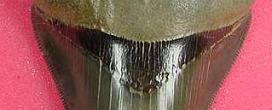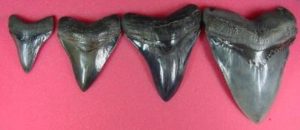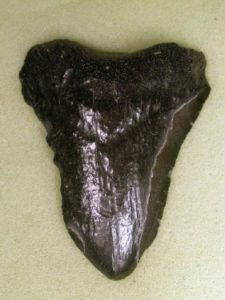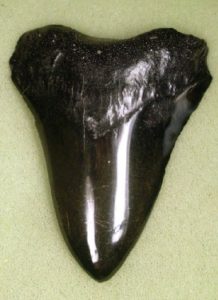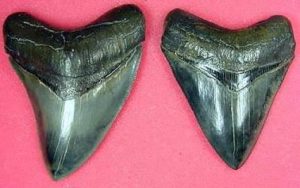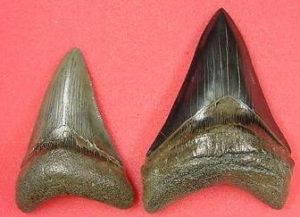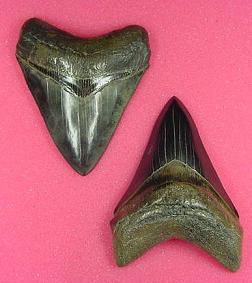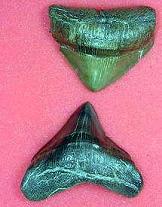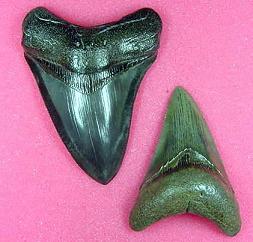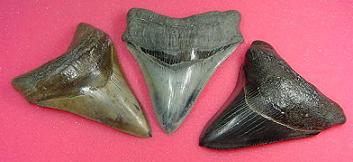Real Megalodon Teeth: The Collector’s Guide
What should I look for when buying a real Megalodon teeth?
This is the question I am most asked. The answer and RULE #1 is Always buy from a trusted source!
Since real Megalodon teeth are the most collected fossil, this guide is what collectors look for to distinguish among authentic Megalodon teeth, including condition, size, price, restoration, shape and color.
Megalodon Tooth Condition
The condition of the enamel, bourrelet, serrations, tip, and root will add or detract from the value of the tooth.
- Enamel: Smooth enamel is an important feature of Meg teeth. The enamel on the tooth on the left is peeled, while the tooth on the right has smooth enamel.
- Root: A complete and perfect root separates a nice tooth from an exceptional tooth. This tooth has nubs on each side which is a rare feature in Megalodon Teeth.
- Bourrelet: This is the thin triangular band of enamel between the blade and the root. Because the bourrelet is so thin, very few Megalodon teeth have a full bourrelet.
Measuring A Real Megalodon Tooth’s Size
The size of a Megalodon tooth is measured in different ways. When people give the size of a tooth in inches, they are generally referring to the diagonal length of the tooth.
Appearances can be deceiving and that is why we always measure with a caliper and show the exact measurement to 1/100 of an inch. Another important determination of the size of the tooth is its weight.
- Diagonal Length: The diagonal length is determined by measuring from the tip of the blade to the corner of the root. When someone tells you that they have a 5″ Megalodon tooth they are saying that the diagonal length of the longer size is 5″. When purchasing a tooth, people usually would like to know the length of both sides of the tooth. This is why you usually see references to two lengths when people are selling a tooth. L1 is the length of the longer side and L2 is the length of the shorter tooth.
- When purchasing a tooth be aware what the person describing the tooth used to measure it. The length of a tooth cannot be accurately determined by using a ruler. A caliper measures lengths to 1/1000 of an inch. Some dealers give an approximate measurement. This is fine until you find that your 6″ tooth is only 5.95″. This may not seem like much of a difference, but it can mean that the tooth is not as valuable. The difference in value between a 5.95″ tooth and a 6″ tooth can easily be hundreds of dollars.
- Always be suspicious when someone selling a tooth tells you that a tooth is 5″ or 5-1/2″. This is a sign that they eyeballed the length with a ruler and it is probably not accurate. The tooth may measure 5.47″, but they round it to 5-1/2″ hoping to get more money than the tooth is worth.
Megalodon Tooth Weight
Just looking at the length of a tooth is not enough. The weight of a Megalodon tooth adds to its overall effect as much as the length does. Two teeth with the same diagonal length can have very different weights. Similarly, the weight of a tooth usually increases greatly with length. An average 5″ tooth is not just an inch longer than an average 4″ Megalodon tooth. It can weigh more than twice as much as the 4″ tooth. In addition, the value of similar teeth increases greatly with size.
The picture above shows a 3″ tooth, 4″ tooth, 5″ tooth and 6-1/8″ tooth side by side. It is clear that there is more to the size difference than simply a 1″ difference in length from tooth to tooth. They weigh 2.5oz. 4oz. 7oz. and 15 oz. respectively
Real Megalodon Tooth Prices
For any price you can get a nicer smaller tooth or a larger tooth that is in lesser condition. Only you can decide if size or condition is more important to you. The hardest thing about buying Megalodon teeth is determining the price.
Every tooth is different. Decide what you want in a tooth, look around and ask questions. It is hard to show what a tooth is really like in a few pictures. Call the seller on the phone and get their assessment of the tooth. See if it is what you really want. Don’t settle for second best.
Megalodon Teeth Restoration
The most common types of altered teeth are repaired teeth and polished teeth.
Repaired Teeth
Damaged teeth can be repaired so that the damage is not noticeable. A broken root or peeled enamel can be added back to make the tooth look more natural. When purchasing a tooth be sure that you know if the tooth has been restored. I find the teeth that I sell and do not repair roots or enamel to teeth. There is nothing wrong with buying a repaired tooth. It is one way to get a larger tooth for less money. Since repaired teeth are worth less than similar unrepaired teeth it is important to know what you are buying.
When you buy a tooth be sure to know whether the tooth has not been repaired, restored or altered. Call the seller and ask questions. Does he know the history of the tooth? Some people are artists and can make alterations that are virtually undetectable. They will add back peeled enamel, a missing root corner or a chipped off tip. There is nothing wrong with this as long as the seller advertises these changes.
Many repaired teeth have been sold on the Internet as unrepaired because the seller did not know the history of the tooth. They bought and sold a tooth that someone altered years ago and never knew it. I find all of the teeth I sell so I can tell you more about it than most resellers can. If you would like a repaired tooth, call me and I can give you the names of dealers that I think do the best job of repairing teeth.
There are only two ways to be sure that you are getting an unaltered tooth. The first and most practical way is to get it from a trusted source. The only other way to be sure is to find it yourself.
Polished Teeth
Polishing a tooth is a way to make a damaged tooth more attractive. A tooth with blade damage can be ground and polished with a diamond polisher. Like repaired teeth, polished teeth let you purchase a larger more attractive tooth for less money. When I sell polished teeth I always clearly label a tooth as polished. Below is an example of a tooth before and after it was polished. You can clearly see how attractive the tooth is after it is polished. Again there is nothing wrong with polished or restored teeth as long as you know what you are getting.
The Shape of A Megalodon Tooth and Position
Some people prefer teeth that have a certain shape. Just like with human teeth, the shape of a shark tooth is determined by the tooth’s jaw position. A tooth in the front of the jaw differs in shape from a tooth towards the back of the jaw.
A tooth in the upper jaw differs in shape from a tooth in the lower jaw. The Megalodon had hundreds of teeth in its massive mouth. There were up to four rows each of upper and lower teeth. These rows were stacked behind one another. When a shark shed a tooth, it had plenty of other teeth to assist it in eating. Each row could contain as many as 30 teeth at one time.
Upper Megalodon Teeth
Teeth in the upper jaw are wider than lower teeth.
Lower Teeth
The lower teeth tend to be narrower than upper teeth. They have a dagger-like shape and the root has a deep V shape.
Types of Real Megalodon Teeth
The types of teeth can be divided into three categories, Anterior, Posterior and Lateral.
Anterior teeth
The teeth in the very front of the Meg’s mouth are anterior teeth. These teeth are wider and longer and have a symmetrical shape. Many people collect anterior teeth because of their shape and size. Many of the larger teeth are anterior teeth.
Posterior Teeth
Teeth in the very back of the Megalodon’s mouth are called posterior teeth and are short wide. This picture shows a pair of posterior teeth, one upper and one lower. These are a favorite of many collectors because of their unusual shape.
Lateral Teeth
These teeth sit between the anterior and posterior teeth. They are thinner than anterior teeth and have a curve or hook.
The picture below shows part of a row of Megalodon teeth. A full row of teeth would not fit on this 64″ stand.
Megalodon Teeth Coloring
Some people ask if you can determine the age of a tooth by the color. The answer is that you cannot. The sediment in which it was buried while fossilizing, not the age of the tooth, determines the tooth’s color. As the tooth decayed, it absorbed the minerals around it which helped to determine the tooth’s color.
The enamel can come in several colors. In short, some collectors prefer one color over another. The teeth above have brown, gray and black enamel There are a lot of factors to consider when buying a Megalodon tooth. If you have any questions call me at 912-656-2920. I would be happy to talk with you and answer any questions.





